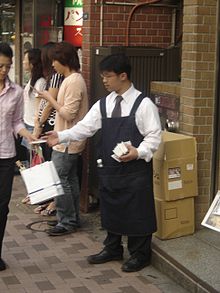Tissue-pack marketing
This article relies largely or entirely on a single source. (June 2021) |

Tissue-pack marketing (ティッシュ配り, Tisshukubari) is a type of guerrilla marketing that attaches advertisements to portable facial tissue packages to move advertising copy directly into consumers' hands. Its origins date back to the late 1960s in Japan as a replacement for free promotional matchboxes, which were falling out of favor.
History
The concept of tissue-pack marketing was first developed in Japan. Its origins date back to the late 1960s when Hiroshi Mori, founder of a paper-goods manufacturer Meisei Industrial Co., was looking for ways to expand demand for paper products. At the time, the most common promotional item in Japan was
Since its creation in Japan, tissue-pack marketing has spread overseas. It was introduced in Montreal, Canada, in December 2000 by Promotion Par Main.[3] In April 2005, the promotional product was also used in Ontario, Canada, by Hold'em Promotions Inc., after the company's founders saw tissue advertising during a trip to China.[4] In the United States, a subsidiary of the Japanese trading company Itochu, AdPack USA, introduced tissue-pack marketing in New York in 2005, and now offers it throughout the country.[1] In 2012, the tissue marketing company Adtishoo launched operations in the United Kingdom.[5]
Benefits

Where the more traditional flyers are often discarded without being read or simply not accepted by the consumer, the same is not true of advertising tissue-packs.[citation needed] The most important reason for this is because the tissues add functionality to the advertisement. This functionality has several benefits:
- Gets the ad into consumers' hands
- In an Internet survey of over 100,000 Japanese consumers conducted by Marsh Research, 76% said they accept free tissues. This is a much higher rate than either fliers or leaflets.[1]
- Gets consumers to read/look at the advert after they have accepted it
- In the same study referenced above, of those that accepted the tissue-pack, slightly more than half of the participants said they either "definitely look" or "at least glance at" the advertisement.[1] One possible reason for this increased statistic when compared to fliers is that consumers were hoping to find coupons or special offers packaged inside with the tissues.
- Helps consumers to retain the ad and its message
- The advertisement on the package is more likely to be retained by the consumer because they are being consistently exposed to it.
See also
- Tissue paper
- Out-of-home advertising
- Communications in Japan
- Marketing strategies
References
- ^ a b c d e Gordenker, Alice (August 8, 2007). "Pocket tissues". The Japan Times. Retrieved June 29, 2021.
- ^ a b "ティッシュ配り、なぜ減った?" [Why did tissue distribution decrease?]. Nikkei Style (in Japanese). September 13, 2010. Archived from the original on June 29, 2021. Retrieved June 29, 2021.
- ^ Berube, Isabelle (2000-12-13). "Promotion Par Main lance ses pub-mouchoirs". Editions Infopresse (in French).
- ^ Perry, Dan (2005-10-20). "A Pack of Success". The UWO Gazette. Archived from the original on 2005-12-26.
- ^ "Adtishoo aims to take off in UK". Manchester Evening News. 2012-06-11.
